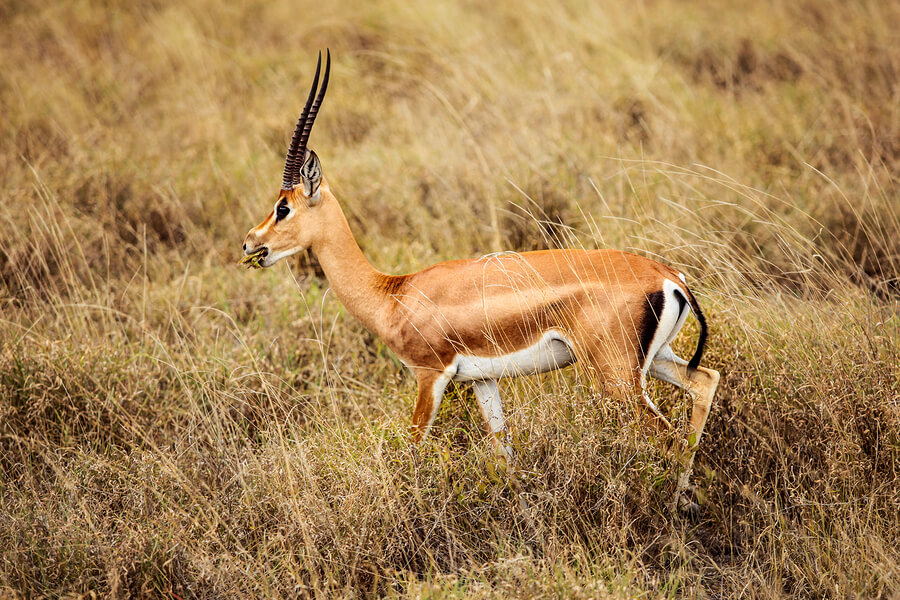Among the many trophy hunts at Lone Oak Adventures, you will find a variety of exotic species from what is known as the bovidae family. Native throughout the continents of Asia and Africa, the bovidae is a class of mammals which include diverse types of wild sheep, gazelles and antelopes. Made up of eight primary subfamilies, the bovidae is further divided up between 143 species of ruminant (otherwise known as herbivores) hoof-cloven mammals. It’s within these subfamilies the antelope and gazelle originate.
The most popular question posed to our hunting guides at Lone Oak Adventures is, “how do the antelopes and gazelles differ?” The answer to that question can provide useful insight into not only tracking these beautiful mammals, but also the best hunting techniques to use, lifespan, appearance, size and their habits.
The Difference Between Gazelles and Antelopes
While many hunters tend to blend the antelope and gazelle into one big group, they are often surprised to find there are actually some pretty major differences between the two. When trying to distinguish the differences, a good rule to remember is that while all gazelles are of the antelope group, not all antelopes are gazelles.
Antelopes
The stately antelope is a wastebasket taxon made up of 91 species consisting of the Gazelle, Oryx, Gemsbok and many more. Regardless of the variety, all antelopes possess a unique characteristic called ungulates – meaning they have even-toed hooves. Additionally, all antelopes have four-chambered stomachs that are able to digest a nutrient rich herbivore diet from grazing the Texas plant life and vegetation.
Although the actual size of antelopes will range between the many species, the overall body mass of antelopes tend to be much larger than that of it’s gazelle subspecies and therefore slower. But don’t mistake these mammals for a sloth. The antelope will leave you high and dry in a New York minute!
The trophy size horns of an antelope are unbranched and never shed while their coats are widely brownish with pale white bellies and are able to withstand fluctuation in ecosystem changes. You see unlike the gazelle, antelopes prefer variety when it comes to it’s environmental habitat. From the arid desert landscape to the crisp cold or saturated waterlogged areas – the antelope feels right at home where it can live between 10-25 years in the Texas wild.
Gazelles
Elegance, stealth-like speed, keen senses and magnificent horns are just a handful of the desired similarities shared between gazelles and antelopes. However, the gazelle is typically fawn colored, are much smaller and faster than its antelope counterpart, thrive in desert-like areas and has only a shorter 10-12 year lifespan.
If it’s a handsome trophy rack that trips your fancy, you’ll be interested to know that both male and female gazelles have horns. Whereas in most antelope varieties, excluding a few like Oryx, only males have horns. But the differences between an antelope and gazelle doesn’t stop there.
Witnessing these spectacular creatures for yourself on a Texas gazelle hunt, you will be quick to notice a peculiar behavior known as ‘slotting’. This distinctive behavior entails the agile gazelle springing vertically into the air with all four legs simultaneously – their backs arched, heads bowed slightly and legs stiff. Once their hooves hit the ground, the gazelle jets to life like a rocket sled on rails. Used to alert fellow herd members of impending danger, deter and defend themselves from predators and oftentimes during play; this signature move is known only to the gazelle.
At Lone Oak Adventures, we believe memories start with a little ingenuity and curiosity with friends and family. If you would like to learn more about the differences of antelope and gazelle trophy hunts, please feel free to contact us today at (210)503-0456. Let our hunting guides make your next hunt legendary.
Original Source: https://loneoakadventures.com/texas-terrain-and-wildlife/what-is-the-difference-between-gazelles-and-antelopes/

